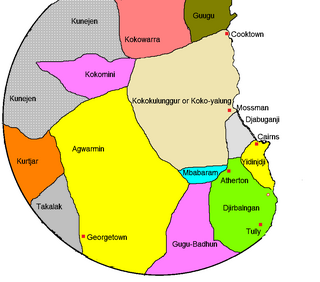| Ritharngu | |
|---|---|
| Ritarungo | |
| Native to | Australia |
| Region | Northern Territory |
| Ethnicity | Ritharrngu |
Native speakers | 32 (2006 census) [1] |
Pama–Nyungan
| |
| Dialects |
|
| Yolŋu Sign Language | |
| Language codes | |
| ISO 639-3 | rit |
| Glottolog | rita1239 [2] |
| AIATSIS [1] | N104 |
Ritharrŋu (Ritharngu, Ritarungo) is an Australian Aboriginal Yolŋu language, spoken in Australia's Northern Territory.

The Australian Aboriginal languages consist of around 290–363 languages belonging to an estimated 28 language families and isolates, spoken by Aboriginal Australians of mainland Australia and a few nearby islands. The relationships between these languages are not clear at present. Despite this uncertainty, the Indigenous Australians' languages are collectively covered by the technical term "Australian languages", or the "Australian family".

The Northern Territory is an Australian territory in the central and central northern regions of Australia. It shares borders with Western Australia to the west, South Australia to the south, and Queensland to the east. To the north, the territory looks out to the Timor Sea, the Arafura Sea and the Gulf of Carpentaria, including Western New Guinea and other Indonesian islands. The NT covers 1,349,129 square kilometres (520,902 sq mi), making it the third-largest Australian federal division, and the 11th-largest country subdivision in the world. It is sparsely populated, with a population of only 246,700, making it the least-populous of Australia's eight states and major territories, with fewer than half as many people as Tasmania.
Dialects are the two moieties of the Ritharrngu people: (a) Ritharngu, and (b) Wagilak. [3] Dhiyakuy (Diakui) has been claimed to be another name, but is not recognized.[ by whom? ] The Manggurra clan now speak Ritharngu, but apparently shifted from Nunggubuyu.
In the anthropological study of kinship, a moiety is a descent group that coexists with only one other descent group within a society. In such cases, the community usually has unilineal descent, either patri- or matri-lineal so that any individual belongs to one of the two moiety groups by birth, and all marriages take place between members of opposite moieties. It is an exogamous clan system with only two clans.
The Ritharngu, also known as the Diakui, are an indigenous Australian people of Arnhem Land in the Northern Territory.




